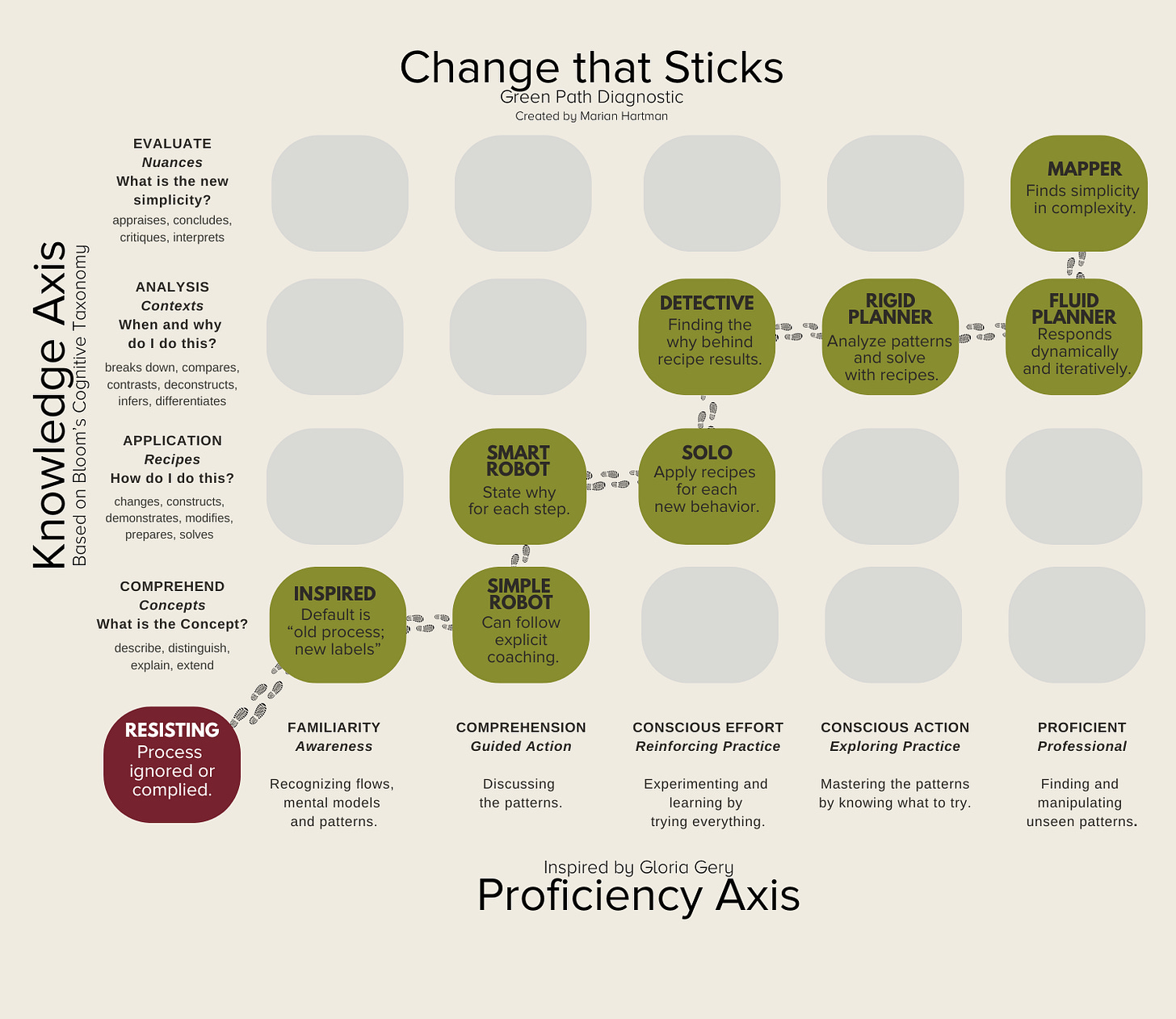All Lego blocks have specific names and uses.
Brick - basic utility block, further identified by size (1x2, 2x2, 4x4, etc).
Corner - L-shaped brick to provide structural support.
Plate - horizontal flat base for structures.
Panel - vertical flat wall surface that connects into structure.
Last week I used Lego for the metaphor to build structurally supporting learning journeys. But just as Lego names its bricks, it is helpful to name our blocks.
Block Zero | Resisting
The very first block that we should recognise isn’t even on the map; but it’s critical to address because so many change programs are swirling here.
In fact, many organizations will feel like transformation has occurred because they successfully moved participants from resisting to inspired— the reality being that they only just got onto the map!
Block 1 | Inspired
Now don’t get me wrong. Getting participants up to and through a phase of inspiration is huge! In a world of cynicism and information overload, that means you’ve cut through the —stuff— and have connected with their hope.
However, this does not mean that they are off to the races and everything is changed. The typical response is simply embracing the new labels onto their old process. Not with malice, but simply out of ignorance. You have their engagement; now let’s help them change.
Block 2 | Simple Robot
This is where the momentum really thrives. They are excited, trying things, and wanting direction. My recommendation for highest success rate is to give them one recipe, or set of instructions for a single behavior change, and then work with them on practicing that single recipe. There’s no deviation as your recipe should address more common issues that your participants will experience.
Block 3 | Smart Robot
Momentum is still working in your favor, but we’re slowing down a little as this is the time to “back up” and start putting some why behind the actions that have been practiced.
Why not simply explain first, then do?
Because they will interpret an explanation based on their existing experience at the time you explain. Explanations to Inspired people will be twisted by their prior experience. Once they simply perform the actions, the explanation will be based on their new experience that includes those actions.
So, just as in Lego Learning, Part 1, a workshop representation of this would be to first have a practice workshop or spend time in a workshop for the recipe (the Simple Robot step), and then another exploratory workshop or later time in that same workshop to explain that practice and how it fits in the new behavior.
Block 4 | Solo
Here’s where so many workshop attendees get thrown to the proverbial wolves. They’ve taken the requisite workshops … now just go perform the skill, right?
No.
In fact, this is one of the most essential points along the journey. They will flounder and figure out how it works with these new behaviors and subsequent recipes. The question is whether they get checked-in support.
Like an early solo-flying pilot, they need continuous connection with their air traffic control tower, or in other words, their coach, mentor, or trusted peer. If they lose contact they’ll either get frustrated and bitter, or simply take much much longer than needed to succeed.
So yes, solo, but solo with a control tower to radio in a lot.
Block 5 | Detective
Notice we’re not moving across the proficiency axis, we’re simply adding knowledge sophistication. Just as we did in Smart Robot, we’ll do the same again— explore the why, but this time on a more sophisticated level. They have more experience and more insight, so their why’s will be more about why something did or did not work.
Block 6 & 7 | Rigid Planner and Fluid Planner
We all know the rigid and fluid planners, right?
Both kinds of planners can analyze the issue in different contexts and come up with solutions. Both planners are skilled confident in [insert skill]. People tend to trust planners at this level of skill as well.
So why do some planners rigidly adhere to their plans, while others inspect and adapt?
Often people think personality makes these planners different, but it’s more about experience with whatever skill they are planning around.
There is no clear cutoff between planning styles, but as there is more exposure and more practice, the planner who was once rigid recognizes the need to be fluid in order to succeed. They also gain the ability to assess a situation quickly and decide when to change the plan. Instead of trying to plan for nuances and surprises, the fluid planner simply makes it easier by inspecting and adapting frequently. This reduces pressure in the system and executive function required to understand the plan.
Block 8 | Mapper
Again, we’re just increasing knowledge sophistication here, and the transition from Fluid Planner to Mapper is grey. But as time and practice goes by, Fluid Planners find themselves more and more looking at the system to help external stakeholders understand, or looking at the system to help internal stakeholders do things more easily.
Their core job shifts from planning their own behavior to generating maps that help others see what to do.
The key knowledge gained here is the creation of generative concepts. They are able to define ideas that they can easily share and which cause others to perform useful behaviors.




